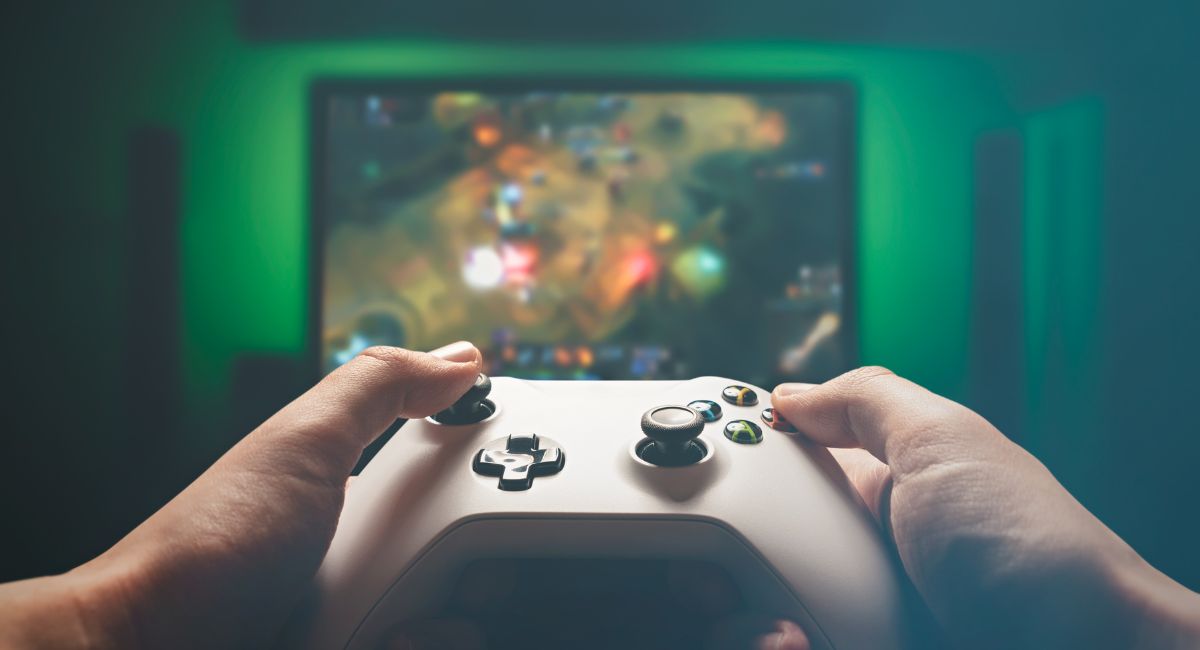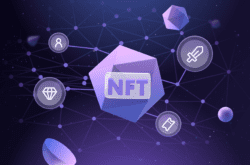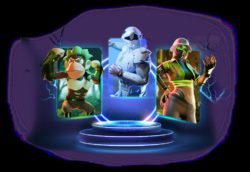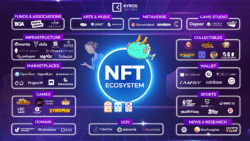Top 10 Ways NFT Gaming Assets Are Improving Web3 Gaming
NFTs, or Non-Fungible Tokens, have gained significant popularity in the digital world, and their application extends beyond art and collectibles into the realm of gaming. NFT gaming assets refer to unique digital items or in-game assets that are tokenized using blockchain technology. These assets can be anything from characters, skins, weapons, virtual real estate, or even entire virtual worlds.
Unlike traditional gaming assets, which are often owned and controlled by the game developer or publisher, NFT gaming assets provide true ownership to the players. Each NFT is unique and cannot be replicated or substituted. They are stored on a blockchain, which acts as a decentralized and transparent ledger, ensuring the provenance, authenticity, and scarcity of these digital items.
NFT gaming assets have several key features and benefits:
1. True Ownership: NFTs allow players to have full ownership and control over their in-game assets. This means they can freely buy, sell, trade, and transfer their NFTs on various online marketplaces, without the need for intermediaries or permission from the game developer.
2. Scarcity and Rarity: NFTs can be designed to have limited supply, making them rare and valuable. This scarcity is enforced by the blockchain technology, ensuring that only a specific number of copies or editions of a particular asset exist. This rarity can increase the desirability and value of these assets among players and collectors.
3. Interoperability: NFTs can be designed to be interoperable across different gaming platforms and ecosystems. This means that a player can use their NFT gaming assets in multiple games or virtual worlds, enhancing their gaming experience and enabling cross-platform functionality.
4. Play-to-Earn: NFT gaming assets have introduced the concept of “play-to-earn,” where players can monetize their time and skills by earning valuable NFTs within the game. These assets can be subsequently sold or traded for real-world currency, providing players with the opportunity to earn income or recoup their investment.
5. Community Engagement: NFT gaming assets foster a vibrant community of players, collectors, and developers. The ownership and trading of these assets create a social and economic ecosystem around the game, where players can interact, collaborate, and support each other.
6. Authenticity and Provenance: Each NFT gaming asset has a unique digital signature stored on the blockchain, verifying its authenticity and provenance. This ensures that players can trust the rarity and uniqueness of the asset they own or wish to acquire.
7. Development Opportunities: NFTs open up new possibilities for game developers to create and innovate. They can design and sell NFT gaming assets, providing an additional revenue stream and empowering them to involve the player community in the creation and evolution of the game.
NFT gaming assets have witnessed significant adoption and success in various gaming genres, such as blockchain-based games, virtual reality experiences, and even traditional games that integrate blockchain technology. These assets have the potential to revolutionize the gaming industry by redefining the relationship between players, developers, and the virtual worlds they inhabit.
What is Web3 gaming?
Web3 gaming refers to the integration of blockchain technology and decentralized principles into the gaming industry. It represents a shift from the traditional centralized gaming model to a more open, transparent, and player-centric ecosystem. Web3 gaming leverages the capabilities of blockchain, cryptocurrencies, smart contracts, and decentralized applications (dApps) to create new gaming experiences and redefine the relationship between players and game developers.
Here are some key aspects and features of Web3 gaming:
1. Decentralization: Web3 gaming platforms are built on decentralized networks like Ethereum, Polkadot, or other blockchain protocols. Instead of relying on a central authority, the game’s rules, assets, and transactions are governed by smart contracts. These smart contracts are self-executing and operate on the blockchain, ensuring transparency, security, and eliminating the need for intermediaries.
2. Ownership of Assets: Web3 gaming enables true ownership of in-game assets through the use of Non-Fungible Tokens (NFTs). Players can acquire, trade, and sell unique and scarce digital items directly on blockchain-based marketplaces. This ownership extends beyond the game itself, allowing players to utilize their assets across multiple games or even in the real world.
3. Play-to-Earn: Web3 gaming introduces the concept of “play-to-earn,” where players can earn rewards, cryptocurrencies, or valuable in-game assets for their time and effort invested in playing the game. These rewards can be traded or converted into real-world value, creating economic opportunities for players.
4. Interoperability: Web3 gaming platforms promote interoperability, allowing players to use their assets and progress across different games and platforms seamlessly. The use of blockchain technology enables cross-platform compatibility, enabling players to retain ownership and utilize their assets in various gaming ecosystems.
5. Community Governance: Web3 gaming platforms often involve the community in decision-making processes through decentralized governance mechanisms. Token holders or active participants can propose and vote on changes, updates, or improvements to the game, fostering a sense of community ownership and participation.
6. Transparent Economy: Blockchain technology provides transparent and auditable transaction records, ensuring fairness and eliminating fraudulent activities like item duplication or cheating. Players can verify the scarcity and authenticity of assets, ensuring a trustworthy and transparent gaming economy.
7. User-Generated Content: Web3 gaming platforms often empower players to create and contribute their own content to the game ecosystem. This can include designing and selling custom assets, creating mods, or even building entire game experiences using decentralized tools and frameworks.
8. Funding and Crowdsourcing: Web3 gaming introduces new funding models, such as Initial Coin Offerings (ICOs) or token sales, to raise capital for game development. It allows developers to directly engage with the player community, involve them in the early stages of development, and provide incentives through token ownership.
Web3 gaming has the potential to revolutionize the gaming industry by offering new possibilities for ownership, monetization, and player engagement. By leveraging blockchain technology, it aims to create a more transparent, inclusive, and player-centric gaming ecosystem, where players have greater control, ownership, and economic opportunities within the virtual worlds they participate in.
Also read: Top 5 Questions Answered About NFTs In Supply Chain
How are NFT gaming assets related to Web3 gaming?
NFT gaming assets and Web3 gaming are closely related concepts that intersect in the realm of blockchain-powered gaming. NFT gaming assets, as unique digital items tokenized on the blockchain, form a fundamental component of the broader Web3 gaming ecosystem. Here’s a detailed exploration of how NFT gaming assets are interconnected with Web3 gaming:
1. Ownership and Control: NFT gaming assets enable true ownership and control for players within the Web3 gaming paradigm. Unlike traditional gaming assets that are owned and controlled by game developers, NFTs empower players to have verifiable ownership of their in-game items. These assets are stored on the blockchain, allowing players to freely buy, sell, trade, and transfer them without the need for intermediaries. Web3 gaming platforms leverage the decentralized nature of NFTs to ensure that players have full control over their digital possessions.
2. Decentralization: Both NFT gaming assets and Web3 gaming embrace the principles of decentralization. NFTs are built on blockchain networks, which operate in a decentralized manner, eliminating the need for a central authority. Web3 gaming platforms leverage this decentralized infrastructure to create a more transparent, secure, and resilient gaming environment. The decentralized nature of blockchain technology ensures that NFT gaming assets cannot be manipulated or tampered with, enhancing trust and fostering a more equitable gaming experience.
3. Interoperability: Web3 gaming platforms strive for interoperability, enabling players to utilize their NFT gaming assets across multiple games and virtual worlds. NFTs are designed to be compatible across various platforms and ecosystems, allowing players to access and use their assets in different games or even in non-gaming contexts. This interoperability fosters a seamless and integrated gaming experience, where players can leverage the value of their NFTs across a broader range of applications within the Web3 gaming landscape.
4. Play-to-Earn: NFT gaming assets and Web3 gaming are intricately linked through the concept of play-to-earn. NFTs enable players to earn valuable assets within games, which can subsequently be monetized or traded for real-world value. Web3 gaming platforms provide the infrastructure and mechanisms to facilitate the exchange of NFT gaming assets for cryptocurrencies or other digital assets. Players can participate in gameplay, complete in-game achievements, or contribute to the gaming ecosystem to earn NFTs and subsequently generate income. This play-to-earn model, supported by NFTs and Web3 gaming, empowers players to derive economic value from their gaming activities.
5. Community Engagement: Both NFT gaming assets and Web3 gaming foster vibrant communities of players, collectors, developers, and enthusiasts. The ownership and trading of NFTs within Web3 gaming platforms create social and economic networks where participants interact, collaborate, and support each other. Players can connect through decentralized marketplaces, social platforms, and governance mechanisms, actively shaping the development and evolution of the gaming ecosystem. This community-driven engagement is a fundamental characteristic of Web3 gaming and is further enhanced by the unique ownership and value propositions of NFT gaming assets.
In summary, NFT gaming assets are a crucial component of the broader Web3 gaming landscape. They facilitate ownership, interoperability, play-to-earn opportunities, and community engagement within decentralized gaming platforms. NFTs empower players with true ownership, control, and monetization possibilities, while Web3 gaming harnesses the power of blockchain technology to create more transparent, inclusive, and player-centric gaming experiences.
Also read: Top 5 Blockchain Gaming Platforms Transforming The Industry
Top 10 ways NFT Gaming Assets are Improving Web3 Gaming
NFTs, or non-fungible tokens, are digital assets that represent ownership of unique items. They have been gaining popularity in recent years, and the gaming industry is no exception. NFT gaming assets are revolutionizing the way games are played, offering players a number of benefits.
Here are the top 10 ways NFT gaming assets are improving Web3 gaming:
- Ownership and control. NFTs give players true ownership of their in-game assets. This means that players can trade, sell, or lend their assets to other players, or even take them with them to other games. This is in contrast to traditional gaming, where in-game assets are owned by the game developers.
- Interoperability. NFTs are interoperable, meaning that they can be used across different games and platforms. This means that players can take their assets with them to different games, or even use them in other applications outside of gaming.
- Encourages creativity. NFTs can be used to create new and innovative game experiences. For example, players can create their own NFT-based games, or they can use NFTs to create unique items and experiences within existing games.

- Increased engagement. NFTs can help to increase player engagement in games. For example, players may be more motivated to play a game if they know that they can earn NFTs as rewards. Additionally, NFTs can be used to create social status within games, which can further motivate players to engage.
- New revenue streams. NFTs can provide new revenue streams for game developers. For example, developers can sell NFTs as in-game items, or they can charge a fee for the use of NFT-based features.

- Transparency and security. NFTs are stored on blockchains, which are transparent and secure ledgers. This means that players can be confident that their NFTs are secure and that they cannot be counterfeited.
- Decentralization. NFTs are decentralized, meaning that they are not subject to the control of any central authority. This means that players have more control over their in-game assets, and they are less likely to be subject to censorship or fraud.
- Community ownership. NFTs can be used to create community ownership of games. For example, players can buy NFTs that give them a stake in the game’s development or profits. This can help to create a more engaged and supportive community around the game.
- Ecosystem growth. NFTs can help to grow the gaming ecosystem. For example, they can be used to create new games, new features, and new ways to interact with games. This can help to attract new players and to keep existing players engaged.
- Future of gaming. NFTs are the future of gaming. They offer a number of benefits that are not possible with traditional gaming, and they are already being used to create new and innovative game experiences. As the technology continues to develop, NFTs will play an even greater role in the gaming industry.
These are just a few of the ways that NFT gaming assets are improving Web3 gaming. As the technology continues to develop, we can expect to see even more innovative and exciting ways to use NFTs in games.
Risks associated with NFT assets and Web3 gaming
While NFT assets and Web3 gaming offer exciting opportunities, it’s important to be aware of the potential risks associated with these technologies. Here are some key risks to consider:
1. Market Volatility: NFT assets, especially those tied to cryptocurrencies, can be subject to significant price volatility. The value of NFTs can fluctuate rapidly, leading to potential financial risks for investors and collectors. The speculative nature of the market can result in sudden price drops, potentially leading to financial losses.
2. Lack of Regulation: The NFT and Web3 gaming space is still relatively new and lacks comprehensive regulation in many jurisdictions. This regulatory uncertainty can make it difficult to address issues such as fraud, scams, and disputes. It’s important for participants to exercise caution and conduct thorough research before engaging in NFT transactions or Web3 gaming activities.
3. Security Concerns: Blockchain technology is generally considered secure, but it is not entirely immune to security breaches. Smart contract vulnerabilities, hacking attempts, and phishing attacks can put NFT assets and user funds at risk. It’s crucial to adopt strong security practices, such as using reputable platforms, securing private keys, and being vigilant against potential threats.
4. Counterfeit and Copyright Infringement: The NFT space has witnessed instances of counterfeit NFTs or unauthorized use of copyrighted material. Due diligence is necessary to verify the authenticity and legality of NFT assets before making any purchases. Intellectual property disputes can arise if NFTs are created without proper authorization, leading to legal consequences and potential loss of value.
5. Environmental Impact: The energy consumption associated with blockchain technology, particularly proof-of-work (PoW) consensus mechanisms, has raised concerns about its environmental impact. PoW blockchains, like Ethereum, require substantial computing power, which consumes significant amounts of energy. The carbon footprint of NFT transactions and Web3 gaming activities should be considered, and efforts should be made to explore more environmentally friendly alternatives, such as proof-of-stake (PoS) blockchains.
6. Lack of Scalability: Blockchain networks, especially those with high transaction volumes, can experience scalability issues. This can lead to network congestion, increased transaction fees, and slower transaction processing times. It may limit the smooth and efficient functioning of Web3 gaming platforms, affecting user experience and adoption.
7. User Experience and Adoption Barriers: The user experience of interacting with NFTs and Web3 gaming platforms can be complex for non-technical users. Cryptocurrency wallets, gas fees, and navigating decentralized applications (dApps) may pose challenges for newcomers. The user interface and onboarding processes need to be improved to enhance accessibility and attract wider adoption.
8. Dependency on Blockchain Infrastructure: NFT assets and Web3 gaming rely on the underlying blockchain infrastructure. If there are issues or limitations with the chosen blockchain network, such as scalability problems, high fees, or governance challenges, it can impact the functionality and viability of NFT assets and Web3 gaming platforms.
It is crucial for participants in the NFT and Web3 gaming space to understand and mitigate these risks. Conducting thorough research, staying informed, using reputable platforms, practicing good security measures, and being aware of regulatory developments can help minimize potential risks and maximize the benefits of engaging with NFT assets and Web3 gaming.
Also read: NFTs In The Metaverse: Top 10 NFTs Are Becoming Very Important Part Of Metaverse
Future of NFT gaming assets and Web3 gaming
The future of NFT gaming assets and Web3 gaming is highly promising, as these technologies continue to evolve and gain traction. Here’s a detailed exploration of their potential future developments:
1. Mainstream Adoption: As awareness and understanding of NFTs and Web3 gaming increase, we can expect a surge in mainstream adoption. The ability to truly own and monetize in-game assets, play-to-earn opportunities, and the community-driven nature of Web3 gaming platforms are likely to attract a broader audience. Major game developers and publishers may integrate NFTs and Web3 features into their existing titles or create new games that leverage these technologies, leading to wider acceptance and integration.
2. Enhanced Gaming Experiences: NFT gaming assets and Web3 gaming have the potential to transform gaming experiences. The use of NFTs allows for unique, scarce, and tradable assets, enabling personalized and diverse gaming experiences. We can expect increased customization options, player-driven content creation, and dynamic in-game economies. Virtual worlds may become more immersive, interconnected, and interactive, fostering deeper player engagement.
3. Cross-Platform Integration: Interoperability is a key aspect of Web3 gaming, and we can anticipate further advancements in cross-platform integration. Players will have the ability to seamlessly transfer their NFT assets across different games, platforms, and virtual worlds. This interoperability will enhance player freedom and flexibility, allowing them to take their assets and progress with them wherever they go.
4. Blockchain Scalability Solutions: Blockchain scalability is a challenge that needs to be addressed for widespread adoption of NFT gaming assets and Web3 gaming. Several projects are actively working on layer 2 solutions, sidechains, and other scalability techniques to overcome limitations and improve transaction throughput. These developments will enhance the efficiency and usability of blockchain networks for gaming purposes.
5. Augmented Reality and Virtual Reality Integration: The integration of NFTs and Web3 gaming with augmented reality (AR) and virtual reality (VR) technologies holds immense potential. NFTs can be tied to physical objects or used to enhance AR experiences, while VR can create immersive virtual gaming worlds where NFTs play a central role. This convergence of technologies will offer entirely new dimensions to gaming and provide players with immersive and interactive experiences.
6. Evolving Business Models: NFT gaming assets and Web3 gaming have the potential to disrupt traditional gaming business models. Developers may explore new revenue streams by selling NFTs directly to players or implementing play-to-earn mechanics. The ability for players to own and trade in-game assets may lead to a more player-centric economy, where value is generated and shared more equitably among participants.
7. Integration with DeFi: The integration of NFT gaming assets with decentralized finance (DeFi) protocols is another area of potential growth. This could involve using NFTs as collateral, earning interest on NFT holdings, or leveraging NFT assets for liquidity provision. DeFi integration can unlock additional value and utility for NFTs, creating synergies between the two ecosystems.
8. Sustainable Solutions: The environmental impact of blockchain technology, particularly proof-of-work blockchains, has been a concern. However, there is growing awareness and efforts to develop sustainable alternatives like proof-of-stake blockchains or energy-efficient solutions. These sustainability initiatives will help address the environmental concerns associated with NFT gaming assets and Web3 gaming.
The future of NFT gaming assets and Web3 gaming is dynamic and full of possibilities. As technology continues to advance, these innovations are poised to reshape the gaming industry, redefine player ownership and engagement, and unlock new economic opportunities within virtual worlds.
Stay informed with daily updates from Blockchain Magazine on Google News. Click here to follow us and mark as favorite: [Blockchain Magazine on Google News].
Get Blockchain Insights In Inbox
Stay ahead of the curve with expert analysis and market updates.
latest from tech
Disclaimer: Any post shared by a third-party agency are sponsored and Blockchain Magazine has no views on any such posts. The views and opinions expressed in this post are those of the clients and do not necessarily reflect the official policy or position of Blockchain Magazine. The information provided in this post is for informational purposes only and should not be considered as financial, investment, or professional advice. Blockchain Magazine does not endorse or promote any specific products, services, or companies mentioned in this posts. Readers are encouraged to conduct their own research and consult with a qualified professional before making any financial decisions. The featured image used is just a creative depiction of the title and it does not intend to hurt sentiments of any person or institution. If it hurts anyone sentiments, please do not hesitate to reach out to Blockchain Magazine.

 Bitcoin
Bitcoin  Ethereum
Ethereum  XRP
XRP  Tether
Tether  Solana
Solana  USDC
USDC  Dogecoin
Dogecoin  Cardano
Cardano  Lido Staked Ether
Lido Staked Ether  TRON
TRON  Wrapped Bitcoin
Wrapped Bitcoin  Chainlink
Chainlink  Wrapped stETH
Wrapped stETH  Sui
Sui  Avalanche
Avalanche  Stellar
Stellar  Shiba Inu
Shiba Inu  Hedera
Hedera  Toncoin
Toncoin  LEO Token
LEO Token  Hyperliquid
Hyperliquid  Bitget Token
Bitget Token  Litecoin
Litecoin  WETH
WETH  USDS
USDS  Polkadot
Polkadot  Bitcoin Cash
Bitcoin Cash  Ethena USDe
Ethena USDe  Wrapped eETH
Wrapped eETH  MANTRA
MANTRA  Uniswap
Uniswap  Pepe
Pepe  Ondo
Ondo  Monero
Monero  Aave
Aave  NEAR Protocol
NEAR Protocol  WhiteBIT Coin
WhiteBIT Coin  Mantle
Mantle  Official Trump
Official Trump  Aptos
Aptos  Dai
Dai  Internet Computer
Internet Computer  Ethereum Classic
Ethereum Classic  Bittensor
Bittensor  Cronos
Cronos  OKB
OKB  POL (ex-MATIC)
POL (ex-MATIC)  Gate
Gate 







